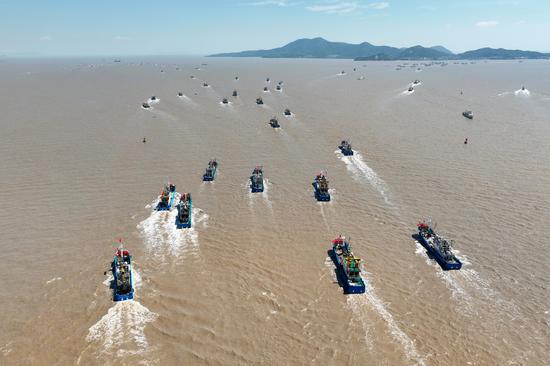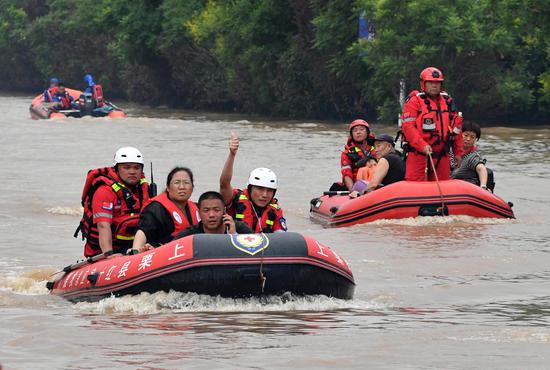Massive evacuation efforts are underway in Northeast China to relocate tens of thousands of people affected by heavy rainfall and flooding, triggered by the residual impact of Typhoon Doksuri.
Floodwaters have damaged houses, bridges, dams, water management facilities and communication and power infrastructure, and inundated agricultural fields in Heilongjiang and Jilin provinces, which received downpours between Aug 1 and Saturday, and are still recording light rainfall, local authorities said.
Shulan, a city in Jilin province, is among the hardest-hit places in the region. As of Sunday night, 14 people, including Shulan's vice-mayor Luo Xudong and two other officials, had died in rain-related incidents.
On Monday, video clips of Luo and the other officials responding to the flood crisis circulated widely on social media. In the videos, the vice mayor is heard issuing evacuation instructions and urging residents not to take any risks.
"Despite knowing there was a 100 percent chance of a flash flood, he bravely and selflessly rushed to the front line. He is an exemplary civil servant," said a user on Sina Weibo.
Jing Junhai, secretary of the Jilin Provincial Committee of the Communist Party of China, sent his condolences on Monday and praised the dedication of the deceased officials to their duties as Party members. He emphasized the need for all departments and authorities to effectively coordinate emergency forces and resources, implement comprehensive measures and minimize casualties.
As of Monday, 79,745 people in Jilin had been evacuated, according to the provincial flood control and drought relief headquarters.
The Northern Theater Command of the People's Liberation Army dispatched an emergency team of 1,000 personnel to Shulan, along with over 100 vehicles, engineering machinery and unmanned search and rescue equipment.
The water levels of major rivers and reservoirs in Shulan have started to recede and remained at a safe operating level, according to the local flood control headquarters.
Meanwhile, more than 50,000 people have been displaced in Wuchang, a county-level city administered by Heilongjiang's provincial capital Harbin. Waterlogging has damaged crops in Wuchang, which is among China's well-known rice producing areas, and in Shangzhi, another county-level city administered by Harbin.
During a meeting held on Sunday on flood control and disaster relief, Xu Qin, Party secretary of Heilongjiang, emphasized that safe evacuation of residents is the priority. He instructed officials to ensure that no one is left behind and stressed the importance of providing temporary shelters, food and medical supplies at relocation sites.
As of 8 am on Monday, 12 rivers in Heilongjiang were flowing above their respective danger levels and five large reservoirs were operating beyond their flood control limits.
The province, which has reported economic losses, is bracing for another spell of heavy rainfall as Typhoon Khanun approaches.


















































 京公网安备 11010202009201号
京公网安备 11010202009201号